Did you know that more than 20% of the vegetables produced globally go to waste? That’s a staggering amount of nutritious food that never reaches our plates. But what if I told you there was a way to unlock the freshness and prolong the life of these vegetables?
Welcome to the vibrant world of frozen vegetables! Freezing vegetables is a fantastic way to preserve their freshness and nutritional value, allowing you to enjoy the flavors and benefits of a bountiful harvest all year round. Whether you buy frozen vegetables from the store or freeze your own, this guide will walk you through the steps to ensure that every bite is packed with taste, texture, and nutritional goodness.
Key Takeaways:
- Freezing vegetables helps reduce food waste and ensures freshness.
- Frozen vegetables can provide the same nutritional benefits as fresh ones.
- Proper freezing techniques maintain the texture and taste of vegetables.
- There are a wide variety of frozen vegetables available, including organic options.
- Cooking methods can enhance the flavors of frozen vegetables.
Harvesting Quality Vegetables
When it comes to freezing vegetables, the key lies in harvesting them at their peak ripeness. This ensures that you capture their vibrant color, rich flavor, and maximum nutritional value. To achieve this, choose vegetables that are free from blemishes, bruises, or overripeness.
Freshness plays a crucial role in preserving the qualities of vegetables during the freezing process. Whether you have a bountiful garden or visit your local market, it’s important to select the freshest produce available for the best freezing results.
“Harvesting vegetables at their peak ripeness is like capturing a moment of nature’s perfection. It ensures that every bite is bursting with flavor and nutritional goodness.” – Jane Smith, Home Cook
By harvesting quality vegetables, you take a proactive step towards preserving their nutritional value and freshness, guiding them towards a delightful journey in the freezer.
Cleaning for Purity
When it comes to frozen vegetables, cleanliness is crucial to ensuring purity and an impeccable taste in every bite. To prepare your vegetables for freezing, follow these simple steps:
- Start by giving your vegetables a gentle rinse under cool, running water. This will help remove any visible dirt and debris, ensuring that your veggies are clean and ready to be preserved.
- For root vegetables that may have stubborn dirt or soil, use a soft brush to gently scrub away any impurities. This extra step will ensure that even the smallest traces of dirt are removed.
- Leafy greens like spinach or kale require special attention. Fill a large bowl or sink with cold water and submerge the greens, gently swishing them around. This will help remove any insects or residues that may be clinging to the leaves.
By transitioning your vegetables from the garden or market to a clean zone, you enhance the taste and guarantee a pure frozen stash. Remember, cleanliness is the key to unlocking the freshness and quality of your frozen vegetables.
The Importance of Cleanliness
Ensuring the cleanliness of your vegetables serves two important purposes. Firstly, it removes any dirt, debris, or impurities that may affect the taste and texture of your frozen vegetables. Secondly, it acts as a defense mechanism against insects or residues that could potentially contaminate your preserved produce. By following proper cleaning techniques, you can rest assured that every bite of your frozen vegetables will be pure and delicious.
“Cleanliness is not just about appearance; it’s about the overall quality and taste of your frozen vegetables. By taking the time to clean your veggies properly, you can enjoy a heightened culinary experience in every dish.”
| Benefits of Cleaning Vegetables | Steps to Ensure Purity |
|---|---|
| Removes visible dirt and debris | Give vegetables a gentle rinse under cool, running water |
| Defends against insects or residues | Use a soft brush for root vegetables if necessary |
| Enhances taste and quality | Clean leafy greens by submerging them in cold water |
Chopping into Convenience
Transforming your clean vegetables into the perfect bite-sized pieces is a game-changer for your future recipes. Whether you prefer chunky or finely chopped, customization is key to catering to your unique cooking preferences. By taking the time to chop your vegetables before freezing, you’re creating bite-sized buddies that will make meal preparation a breeze.
Imagine this: you reach into your freezer, and there they are, your pre-chopped treasures, ready to be added to any dish you desire. No more tedious chopping sessions while your stomach grumbles impatiently. With pre-chopped vegetables at your fingertips, you’ll save valuable time and effort in the kitchen.
Transitioning from the chopping board to the freezer is a seamless process that sets the stage for simplified meal preparation. By having your vegetables already chopped and waiting for you, your cooking experience becomes effortless and enjoyable.
Customization is Key
When it comes to chopping vegetables, the world is your oyster. You can customize the sizes and shapes to your heart’s content, tailoring them to match your preferred cooking methods and culinary creations. From dicing carrots for your homemade soup to slicing bell peppers for your stir-fry, the possibilities are endless.
“Chopping vegetables is like creating art in the kitchen. It allows you to showcase your personal touch and preferences while adding convenience to your cooking routine.”
The beauty of chopping vegetables before freezing is that you have full control over the end result. No more oversized chunks or inconvenient sizes—everything is tailored to your liking. It’s like having your own customized vegetable arsenal, ready to elevate your dishes to the next level.
A Picture-Perfect Table
To further illustrate the benefits of chopping vegetables, let’s take a look at the table below. It showcases the various sizes that vegetables can be chopped into and the dishes they are commonly used in. From bite-sized cubes to slender strips, each size enhances different cooking techniques and recipes.
| Chop Size | Common Uses |
|---|---|
| Small dice (¼-inch cubes) | Veggie-packed soups, stews, and casseroles |
| Medium dice (½-inch cubes) | Roasted vegetables, grain bowls, and stir-fries |
| Julienne (thin strips) | Stir-fries, salads, and spring rolls |
| Matchstick (slender sticks) | Pad Thai, stir-fries, and vegetable noodles |
| Rough chop (irregular pieces) | Soups, stews, and vegetable medleys |
As you can see, the possibilities for chopping vegetables are vast, and each size unlocks a world of culinary creativity.
With your vegetables prepped to perfection, you’re ready to explore the next step: blanching. Stay tuned for Section 5, where we dive into the secrets of preserving freshness through this simple yet powerful technique.
Blanching for Freshness
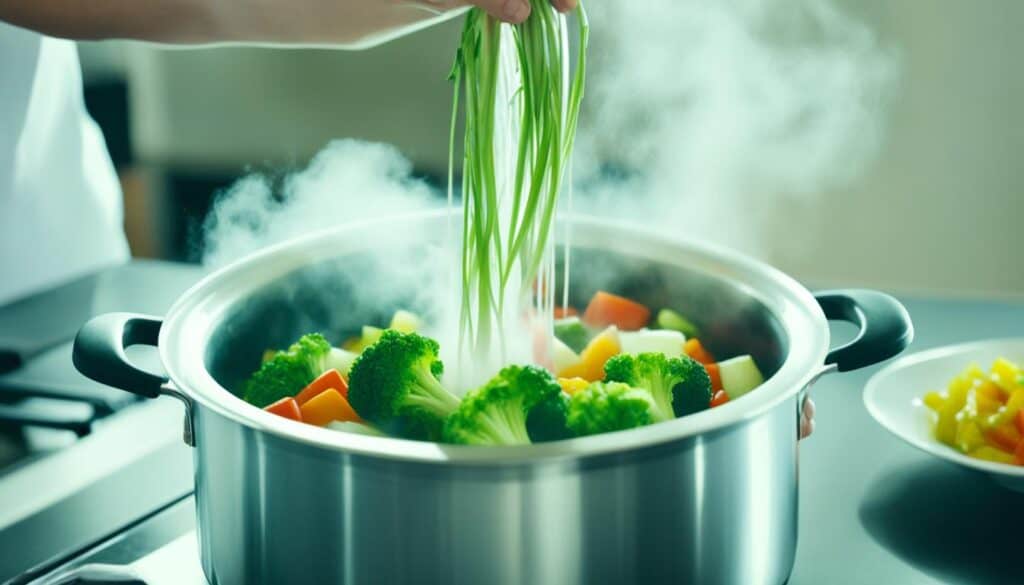
When it comes to preserving the vibrant colors and deliciousness of vegetables, blanching is the secret weapon every home cook should have in their arsenal. This simple yet effective technique involves briefly immersing vegetables in boiling water followed by immediate cooling.
Blanching vegetables not only helps to lock in their vibrant colors but also preserves their natural flavors and nutritional value. The process of blanching stops the enzymes that can cause loss of quality over time, ensuring your vegetables stay fresh and delicious for longer.
To blanch vegetables, start by bringing a pot of water to a rolling boil. Carefully add the vegetables and cook them for a short period, typically one to three minutes, depending on the specific vegetable and its size. This short exposure to heat helps to wake up the flavors and locks in their freshness.
Once the blanching time is up, it’s essential to cool the vegetables immediately to halt the cooking process. Plunge the blanched vegetables into an ice bath, which is a bowl of ice water. The ice bath not only stops the cooking but also helps to maintain the crispness and texture of the vegetables, ensuring they remain as delightful as the day they were harvested.
Blanching not only gives your vegetables a head start in terms of preserving their quality, but it also offers a practical benefit when it comes to meal preparation. By blanching vegetables before freezing them, you can save time and effort when cooking. You can quickly incorporate blanched vegetables into your favorite dishes without the need for additional cooking time.
So, the next time you have an abundance of fresh produce, consider blanching it before freezing. Not only will you preserve the vibrant colors and deliciousness of your vegetables, but you will also have a stash of conveniently prepared ingredients ready to be transformed into culinary delights.
| Vibrant Colors | Deliciousness | Preserving Vegetables |
|---|---|---|
| Retains the vibrant colors of vegetables, even after freezing. | Preserves the natural flavors, ensuring every bite is as delicious as the day the vegetables were harvested. | Stops enzymes that can cause loss of quality over time, preserving the freshness and nutritional value of the vegetables. |
| Keeps vegetables visually appealing, enhancing the aesthetic appeal of your dishes. | Allows you to enjoy the full flavor profile of your favorite vegetables in various recipes. | Ensures your frozen vegetables maintain their quality for an extended period. |
Draining Excess Moisture
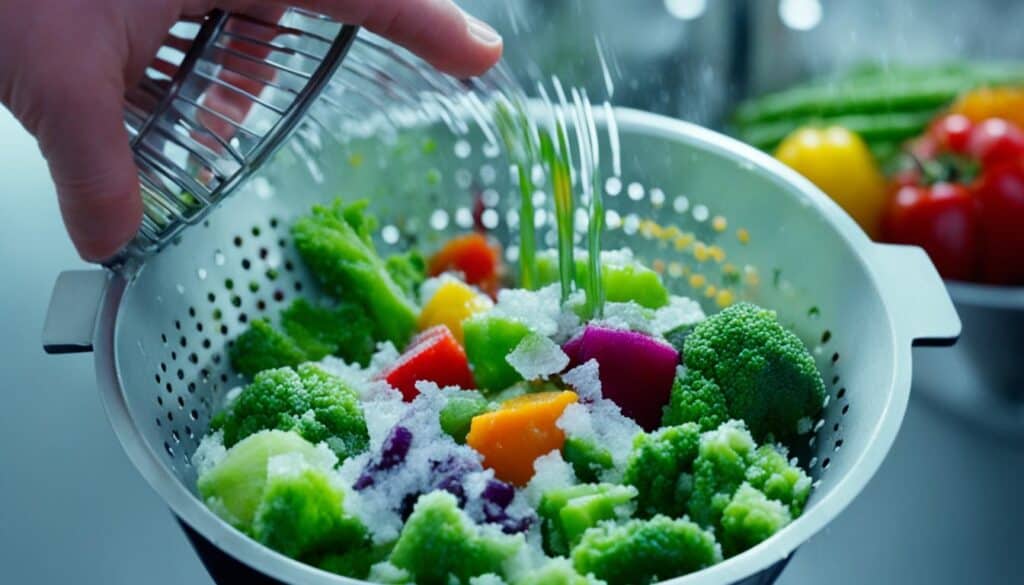
After blanching, it is essential to drain excess moisture from your vegetables. This simple step is crucial in preventing the formation of ice crystals and maintaining the optimal texture and taste of your frozen vegetables.
When moisture freezes, it can turn into ice crystals, which can negatively impact the quality of your vegetables. By draining the excess moisture, you ensure that each individual vegetable retains its unique characteristics and doesn’t clump together.
Properly drained vegetables will freeze more evenly and retain their texture, flavor, and nutritional value. This ensures that when you’re ready to use them in your favorite recipes, they taste just as fresh as when they were harvested.
Here’s how you can drain excess moisture from your blanched vegetables:
- Using a colander, carefully transfer the blanched vegetables from the pot into the colander held over a sink.
- Allow the vegetables to sit in the colander for a few minutes, allowing any excess water to drain away.
- Gently shake the colander to help remove any remaining moisture.
- Pat the vegetables dry with a clean kitchen towel or paper towels to remove any remaining moisture.
Once you’ve completed the draining process, your vegetables are ready to embark on their icy adventure in the freezer. By taking the time to drain the excess moisture, you are preserving the texture and taste of your vegetables, ensuring that they maintain their quality throughout their frozen storage.
Freezing for Future Feasts
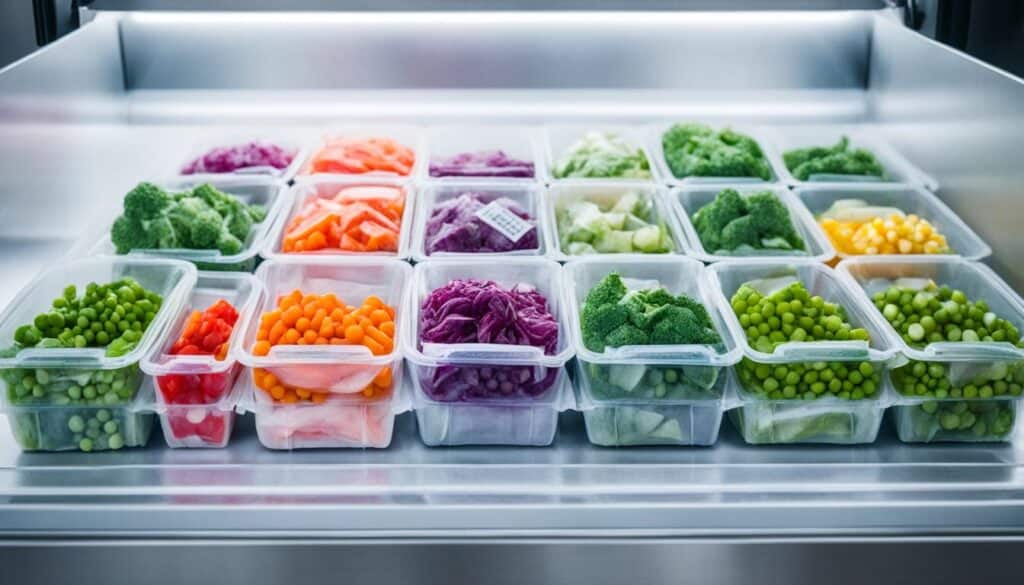
When it comes to freezing vegetables, a little strategic planning goes a long way in preserving their freshness and ensuring they remain easily accessible for your culinary creations. By orchestrating the flavors and preventing clumping, you can take what you need when you need it, without any wastage. Let me walk you through some tips to master the art of freezing vegetables.
Strategically Placing Vegetables in the Freezer
Start by placing your prepared vegetables strategically in the freezer. This helps maintain their freshness and quality over time. Consider using trays or individual containers to prevent clumping and make it easier to take out only what you need without any hassle.
“By spacing out your vegetables or using individual containers, you can prevent clumping and preserve the texture, taste, and overall deliciousness of each vegetable.”
Preserving Texture and Taste
When freezing vegetables, it’s important to take steps to preserve their texture and taste. By preventing clumping, each vegetable retains its individuality, ensuring a delightful eating experience. Whether it’s crispy green beans, tender corn kernels, or vibrant bell peppers, you’ll be able to enjoy the same quality as when they were freshly harvested.
Easily Accessible and Convenient
Freezing vegetables in a thoughtful arrangement not only maintains their freshness but also ensures easy access whenever you need them. Imagine having a bounty of frozen vegetables at your fingertips, ready to be added to soups, stews, stir-fries, or any other dish you desire without the need for extensive preparation. It’s a time-saving and convenient solution for busy home cooks!
In conclusion, by freezing vegetables in a strategic manner, you can preserve their flavors, prevent clumping, and make them readily available for your cooking needs. Take advantage of the convenience and versatility of frozen vegetables to elevate your culinary creations, no matter the season or occasion.
The Versatility of Frozen Vegetables
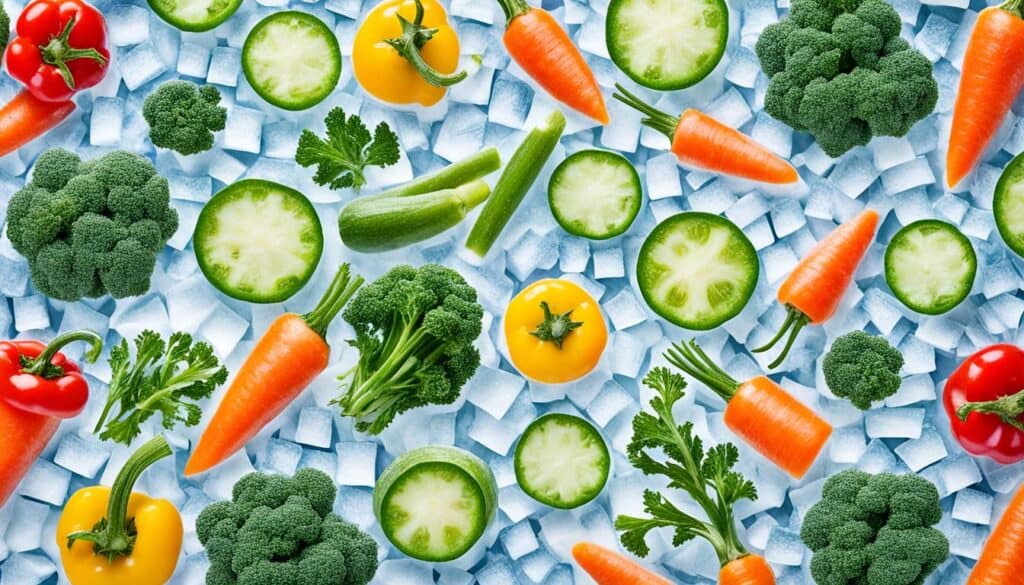
Frozen vegetables have come a long way in the past century. Clarence Birdseye’s mass-produced frozen peas were just the beginning. Now, an array of vegetables can be found in the frozen section, such as butternut squash, Swiss chard, asparagus, mushrooms, and more. Don’t limit yourself to the usual standbys; explore the expanding options for frozen vegetables and discover new culinary delights.
Modern Freezing Techniques
Thanks to modern freezing techniques, a wide variety of vegetables can be conveniently enjoyed year-round. From exotic choices to seasonal favorites, the freezer aisle offers a cornucopia of options to elevate your dishes. Whether you’re craving an earthy mushroom risotto or a comforting butternut squash soup, the frozen vegetable selection has you covered.
With these modern freezing techniques, vegetables retain their nutritional value, texture, and flavor. Flash-freezing locks in freshness and preserves the nutrients, ensuring you still get a healthy serving of vitamins and minerals. So you can enjoy the taste and goodness of your favorite vegetables no matter the season.
Expanding Culinary Options
The expanding options for frozen vegetables open up a world of culinary possibilities. Gone are the days of being limited to basic peas and corn. Now, you can experiment with a diverse range of vegetables to add vibrant colors, textures, and flavors to your dishes.
Try incorporating frozen asparagus into a savory quiche, or sauté frozen Swiss chard with garlic and olive oil for a nutritious side dish. The versatility of frozen vegetables allows you to effortlessly whip up creative meals that will impress your family and friends.
Whether you’re a seasoned chef or a home cook looking to expand your repertoire, frozen vegetables offer endless inspiration. With such a wealth of options at your fingertips, you can unleash your culinary creativity and elevate every meal.
| Popular Frozen Vegetable Varieties | Description |
|---|---|
| Butternut Squash | A sweet and nutty winter squash that adds depth to soups, stews, and risottos. |
| Swiss Chard | A leafy green with colorful stems that can be sautéed or used in salads for a burst of flavor. |
| Asparagus | A versatile vegetable that can be grilled, roasted, or added to pasta dishes. |
| Mushrooms | An umami-packed ingredient that adds richness to sauces, stir-fries, and pizzas. |
Explore the frozen vegetable section of your local grocery store or order online to discover the plethora of options available. From classics to unique varieties, frozen vegetables offer a convenient and flavorful way to enhance your meals.
Cooking with Frozen Vegetables
Treat frozen vegetables like fresh ones when it comes to cooking methods. By properly applying dry heat methods, such as sautéing and roasting, you can unlock flavors and create caramelization, enhancing the taste of frozen vegetables.
Avoid using moist heat methods, such as steaming or microwaving, as they may not bring out the best in frozen veggies. Stick to skillets or sheet pans for the best cooking results.
Sautéing:
Sautéing frozen vegetables in a hot pan with a little oil or butter can yield delicious results. The dry heat method allows the vegetables to sizzle and brown, enhancing their natural flavors. Toss them occasionally to ensure even cooking and caramelization. Serve as a side dish or incorporate them into stir-fries for a quick and healthy meal.
Roasting:
Roasting frozen vegetables in the oven can transform them into a delectable dish with charred edges and a rich, savory flavor. Preheat the oven to a high temperature, spread the vegetables evenly on a sheet pan, drizzle with oil, and toss to coat. Roast them until they become tender and caramelized, occasionally flipping them for even browning. Enjoy them as a standalone dish or mix them into grain bowls or pasta for added texture and flavor.
Unleash the culinary possibilities of frozen vegetables with dry heat cooking methods. Whether sautéing or roasting, these techniques will elevate the taste and texture of your frozen vegetable creations. Embrace the convenience and savor the deliciousness!
| Cooking Methods | Description |
|---|---|
| Sautéing | Quickly frying the frozen vegetables in a pan with oil or butter to enhance flavors and achieve caramelization. |
| Roasting | Cooking the frozen vegetables in the oven at a high temperature to achieve a crispy exterior and tender interior. |
Proper Storage of Frozen Vegetables
Proper storage is key to preserving the quality and freshness of your frozen vegetables. By following these guidelines, you can prevent moisture loss and ensure that your veggies stay delicious and nutrient-rich.
Preventing Moisture Loss
Moisture loss can lead to the formation of unsightly ice crystals and a decline in texture and taste. To prevent this, it’s essential to store your frozen vegetables in airtight containers or freezer bags. Make sure they are sealed securely to minimize exposure to air and moisture.
By keeping moisture locked in, you can enjoy perfectly preserved vegetables that retain their natural flavors and textures.
Using Within a Week or Two
“To maintain optimal quality, it is recommended to use your frozen vegetables within a week or two after opening the package. This ensures that you consume them while they are still at their peak freshness. It’s like having your own garden harvest available all year round!”
– Sarah’s Frozen Food Blog
While frozen vegetables can be stored for longer periods, they are best enjoyed when used relatively soon after opening. This allows you to savor the full flavors and nutritional benefits they offer.
Proper Storage Tips:
- Label your containers or freezer bags with the date of freezing to keep track of their freshness.
- Store your frozen vegetables at a consistent temperature below 0°F (-18°C) to maintain their quality.
- Avoid fluctuating temperatures by placing your frozen veggies in the coldest part of your freezer, away from the freezer door.
- Separate larger quantities into smaller portions for easier access and to minimize the time the container needs to be opened.
By storing your frozen vegetables properly, you can ensure a bountiful supply of delicious and nutritious veggies for your cooking endeavors.
| Storage Tips | Benefit |
|---|---|
| Use airtight containers or freezer bags | Prevents moisture loss and freezer burn |
| Label containers with freezing date | Track freshness and prioritize consumption |
| Store at consistent sub-zero temperatures | Maintains quality and prevents spoilage |
| Place in coldest part of the freezer | Minimizes temperature fluctuation |
| Separate into smaller portions | Easier access and minimized exposure to air |
By taking these simple steps to store your frozen vegetables properly, you can enjoy the convenience and flavors of your favorite veggies throughout the year.
Storing Fresh Vegetables
Proper storage of fresh vegetables is essential to maintain their freshness. To make the most of your garden harvest or recent market finds, it’s important to know the optimal storage methods for different types of vegetables.
“Knowing how to store fresh vegetables can significantly extend their shelf life and preserve their flavor and nutritional value.”
Refrigerator Storage
Some vegetables should be stored in the refrigerator immediately to maintain their freshness. Leafy greens, such as spinach and kale, should be rinsed under cool water to remove any dirt or debris. Then, wrap them in a paper towel or tea towel to absorb excess moisture and place them in a container or sealed plastic bag. This method helps keep the greens crisp and fresh for longer.
Other vegetables, such as broccoli and carrots, can also be stored in the refrigerator. Before refrigerating, make sure to remove any unnecessary parts like broccoli stems or carrot tops to prevent spoilage. Then, place them in a perforated plastic bag or wrap them in a moist paper towel to maintain their moisture levels and prevent them from drying out.
Ripening Before Refrigeration
On the other hand, some vegetables need to ripen before being refrigerated. This is the case for tomatoes, avocados, and bananas. These soft-fleshed fruits and vegetables develop their optimal flavor and texture when allowed to ripen at room temperature. Once they have reached the desired ripeness, they can be refrigerated to extend their shelf life.
Storing Fresh Vegetables: A Handy Guide
| Vegetable | Storage Method |
|---|---|
| Leafy Greens (Spinach, Kale, Lettuce) | Rinse, wrap in paper towel or tea towel, refrigerate in a container or sealed plastic bag |
| Broccoli, Carrots | Remove unnecessary parts, place in perforated plastic bag or wrap in a moist paper towel, refrigerate |
| Tomatoes, Avocados, Bananas | Ripen at room temperature, then refrigerate |
By following these storage guidelines, you can keep your fresh vegetables at their best for longer periods, ensuring that they retain their flavor, nutrients, and crispness.
Conclusion
Frozen vegetables offer a gateway to year-round culinary brilliance. By following the steps outlined in this guide, you can unlock freshness and preserve the flavors of your bountiful harvest. Embrace the convenience of frozen vegetables and let your freezer become a source of joy in every kitchen creation. With a freezer stocked with these nutritional powerhouses, you can experience the culinary brilliance of vibrant vegetables at any time.
Freezing your produce at the peak of freshness ensures that you have a year-round supply of flavorful ingredients. Whether you’re in the mood for a hearty stew, a refreshing salad, or a colorful stir-fry, frozen vegetables provide year-round convenience without compromising on taste or nutrition. With the right techniques, you can savor the bountiful harvest of nature’s finest offerings in the comfort of your own home.
So, as you embark on your frozen vegetable journey, remember to grow fresh and freeze right. Explore the modern freezing techniques and variety available in the frozen section. Discover the culinary brilliance that frozen vegetables bring to your meals. Take delight in the convenience and versatility they offer. It’s time to rejoice in the culinary wonders that can be created with the bountiful harvest of frozen vegetables.
FAQ
Why should I freeze my vegetables?
When is the best time to harvest vegetables for freezing?
How do I clean vegetables before freezing?
Should I chop the vegetables before freezing?
What is blanching and why is it important?
Why is draining excess moisture important?
How should I strategically freeze my vegetables?
What types of vegetables can I find in the frozen section?
How should I cook frozen vegetables?
How long can I store frozen vegetables?
How should I store fresh vegetables?
What can frozen vegetables offer me?
Source Links
- https://www.thespruceeats.com/4-mistakes-to-avoid-with-frozen-vegetables-4843263
- https://www.unlockfood.ca/en/Articles/Cooking-Food-Preparation/How-to-store-vegetables-to-keep-them-fresh.aspx
- https://ecoindoorgardening.com/edible-gardening/vegetables/preserving-freshness-learn-how-to-prepare-vegetables-for-freezing/

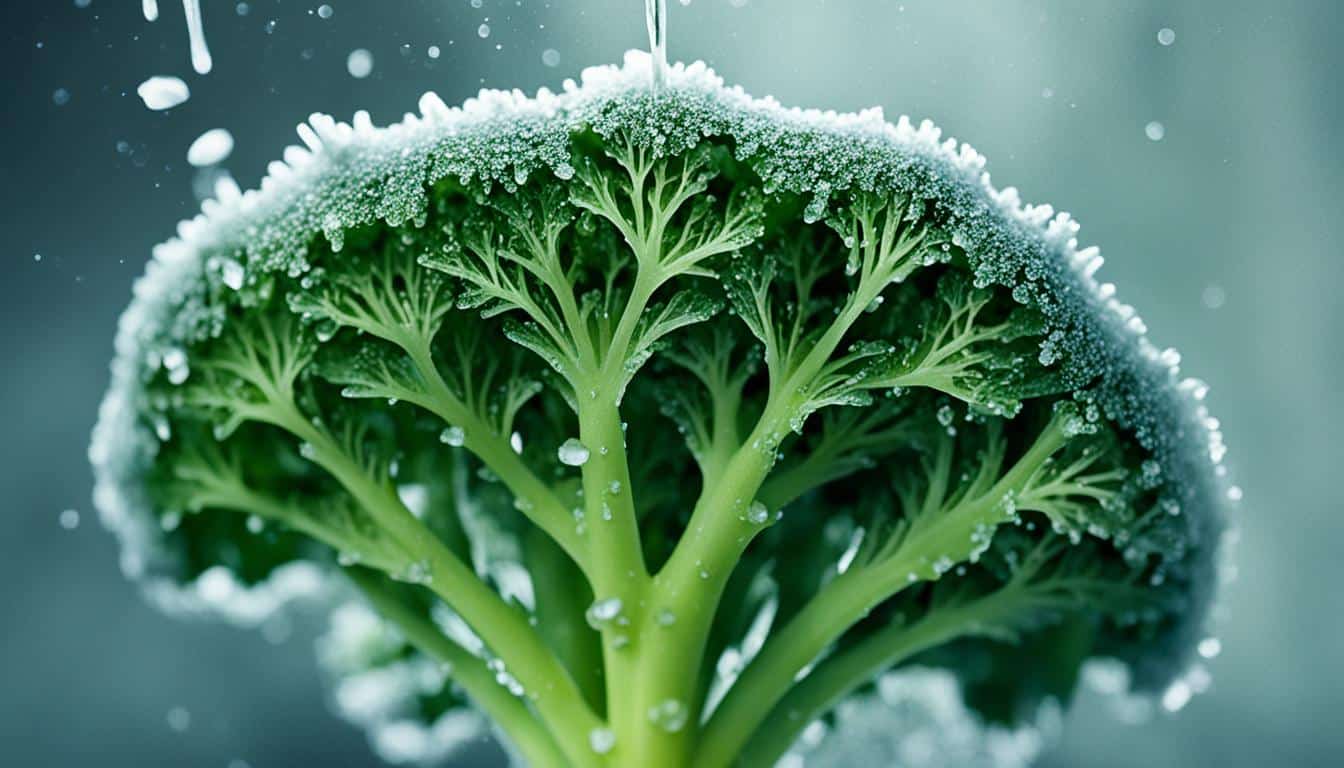



Leave a Reply